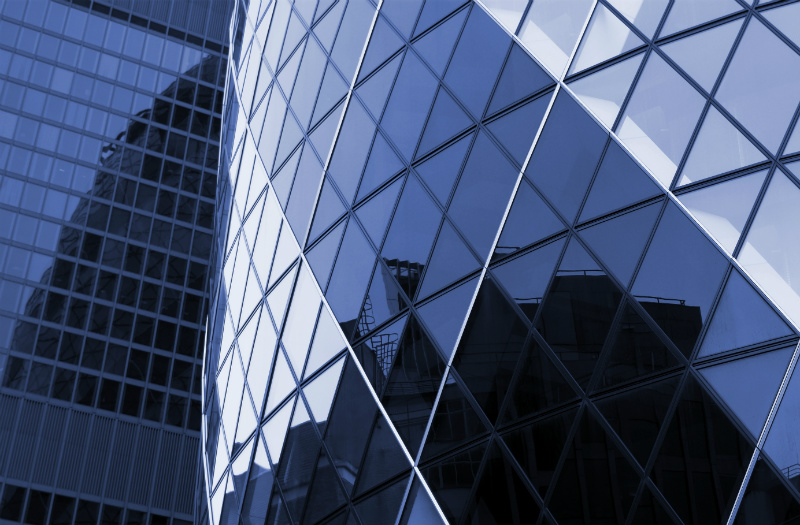
From London’s Canary Wharf to Manhattan and Shanghai, glass is the dominant feature of many a modern city skyline.
Yet, the lustre of these high-rise, panoramic fixtures is under revision, as evidenced earlier this year when New York Mayor Bill de Blasio revealed he was considering a bill that would prohibit the construction of new glass skyscrapers in the city.
The reasoning behind the potential move is simple. All-glass façade skyscrapers require substantial energy to both heat and cool, rendering them, in de Blasio’s words, “incredibly inefficient”. As New York pursues its recently-passed New Green Deal – which aims to achieve a net-zero carbon economy by 2050 – traditional glass facades simple won’t do.
Fortunately, architects and engineers are not entirely without options. Concepts such as double skin facades – consisting of two layers of glass, with a gap in the middle – allow for better insulation and thermal efficiency. The Norman Foster-designed 30 St Mary Axe – better known as the Gherkin – is perhaps the best-known exponent of such technology.
Windows of opportunity: The benefits of self-cleaning glass
It’s been 16 years since St Helens-headquartered Pilkington pioneered the first commercially available self-cleaning glass. A dual-action product, Pilkington’s cleaning process is comprised of two stages. The first is photocatalytic, in which the coating reacts with natural light to break down dirt that has accumulated on the window. This, in turn, makes the glass surface hydrophilic, whereby rainwater hits the glass, washing off organic dirt and mineral materials.
The benefits of self-cleaning glass are obvious. It has the potential to more than halve façade maintenance, which can be both costly and laborious, due to the requirement of scaffolding, cranes and manpower.
Writing in a blog post on the company’s website last year, Phil Brown, Pilkington’s regulatory marketing manager, claimed it had sold more than ten million square metres of its self-cleaning glass since its launch in 2002 – enough to cover a football pitch 1,380 times over – but it remained a product that “some in the industry still have misconceptions about.”
Smart facade technology: Much potential but uptake remains slow
Generally speaking, the same goes for smart façades space, where intrigue still outweighs actual uptake.
“There’s a lot of potential with smart façades, given their ability to adapt to environmental conditions, responding to changes both outside and inside a building,” explains Barry Patrick, an associate at Perega Clear Structures, a glass engineering consultancy.
“The combined qualities of soundproofing, self-regulating heat, ventilation and solar protection measures make them a highly desirable sustainable solution. In light of the climate emergency, they offer great potential to contribute to a building’s energy efficiency. However, budgetary limitations mean uptake is slow, further impacted by the scale and size of the design-build.”
Ian McCormack, managing director of Ireland-based Carlen Glass, also sees smart glass as a technology with significant potential. He cites the likes of transparent solar panels, invisible monitor displays and opacity switches as technologies which all might find their way into the construction of new buildings.
But, like Patrick, he has reservations that smart glass is ready for imminent take-off. “The truth is that we are only just beginning to see the potential of this technology,” he says.
“There’s always a cycle for niche expensive products. They start off fictional or theoretical, then they move into reality but stay with the fringes and tech enthusiasts, only becoming accessible to average consumers if they’re seen to be important enough. This is where we are at with smart glass.”
Beyond smart glass, Barcelona’s Institute for Advanced Architecture of Catalonia (IAAC) has undertaken a project examining the benefits of hydroceramic facades as a means of cooling down buildings in hot countries. Known as “breathing” buildings, hydroceramics contain an insoluble polymer able to absorb up to 500 times its weight in water. This, in turn, enables the panels to absorb humidity and let it evaporate – hence the likeness to breathing.
The IAAC claim the technology could help buildings slash their energy bills by a third. Cameron Dean of Weldwide, a London-based architectural and structural metal firm, has been keeping a keen eye on some of the latest developments in Barcelona.
“Breathing buildings may provide a cheap, sustainable, cost-effective way to massively reduce energy bills across the board in hot countries over the long term,” he says.
Future progress: Waiting for prices to drop
Irrespective of whether Mayor de Blasio is able to pass his bill that would ban the construction of glass skyscrapers in New York, the relationship between modern architecture and environmentalism is changing. The climate crisis has seen to it that new buildings must be constructed in a way that is pursuant to the green agenda.
So, could smart facade technology make a difference?
“The market potential is huge, due in no small part to macroeconomic trends like environmental sustainability, which is driving this particular technology forward due to its ability to drive down air conditioning costs and capture solar energy,” believes McCormack.
“Smart glass is on the precipice of converging beneficial factors that will increase its demand and drive its price down. As solar energy becomes more efficient and stays on track to grow its profits year on year, businesses will look to capitalise on this new real estate.”
Patrick is in concurrence: as more technologies are patented, developed and made commercially available, so prices should eventually drop. Perhaps then we might see smart facade technology of glass become a welcome, contemporary feature of the city skyscape.
“As technology advances, designing for energy optimisation is increasingly more attainable and effective,” he says. “Currently, this still comes at a cost, which will hopefully decrease as these technologies become more widely specified. However, this needs to be weighed against the serious cost to our climate if sustainable, energy-efficient solutions are not pursued in earnest.”



